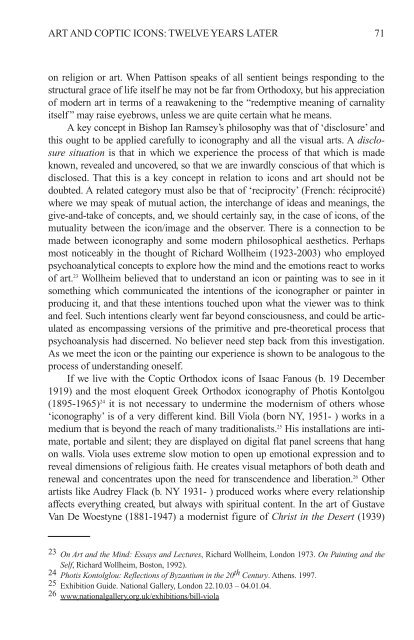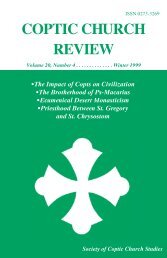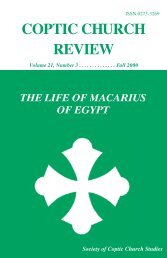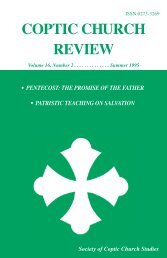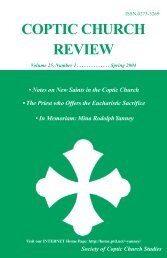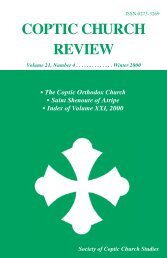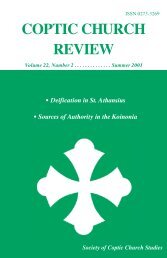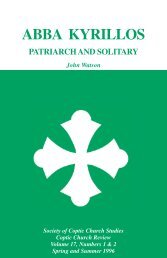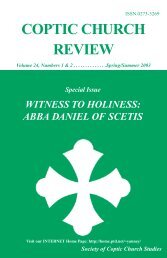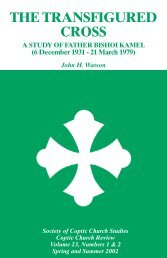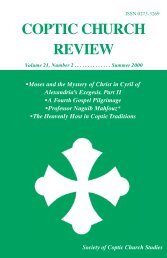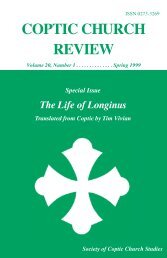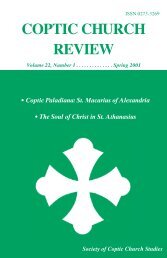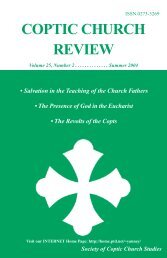2004 Fall.Vol25.#3.pdf - Coptic Church Review
2004 Fall.Vol25.#3.pdf - Coptic Church Review
2004 Fall.Vol25.#3.pdf - Coptic Church Review
Create successful ePaper yourself
Turn your PDF publications into a flip-book with our unique Google optimized e-Paper software.
ART AND COPTIC ICONS: TWELVE YEARS LATER 71<br />
on religion or art. When Pattison speaks of all sentient beings responding to the<br />
structural grace of life itself he may not be far from Orthodoxy, but his appreciation<br />
of modern art in terms of a reawakening to the “redemptive meaning of carnality<br />
itself ” may raise eyebrows, unless we are quite certain what he means.<br />
A key concept in Bishop Ian Ramsey’s philosophy was that of ‘disclosure’ and<br />
this ought to be applied carefully to iconography and all the visual arts. A disclosure<br />
situation is that in which we experience the process of that which is made<br />
known, revealed and uncovered, so that we are inwardly conscious of that which is<br />
disclosed. That this is a key concept in relation to icons and art should not be<br />
doubted. A related category must also be that of ‘reciprocity’ (French: réciprocité)<br />
where we may speak of mutual action, the interchange of ideas and meanings, the<br />
give-and-take of concepts, and, we should certainly say, in the case of icons, of the<br />
mutuality between the icon/image and the observer. There is a connection to be<br />
made between iconography and some modern philosophical aesthetics. Perhaps<br />
most noticeably in the thought of Richard Wollheim (1923-2003) who employed<br />
psychoanalytical concepts to explore how the mind and the emotions react to works<br />
of art. 23 Wollheim believed that to understand an icon or painting was to see in it<br />
something which communicated the intentions of the iconographer or painter in<br />
producing it, and that these intentions touched upon what the viewer was to think<br />
and feel. Such intentions clearly went far beyond consciousness, and could be articulated<br />
as encompassing versions of the primitive and pre-theoretical process that<br />
psychoanalysis had discerned. No believer need step back from this investigation.<br />
As we meet the icon or the painting our experience is shown to be analogous to the<br />
process of understanding oneself.<br />
If we live with the <strong>Coptic</strong> Orthodox icons of Isaac Fanous (b. 19 December<br />
1919) and the most eloquent Greek Orthodox iconography of Photis Kontolgou<br />
(1895-1965) 24 it is not necessary to undermine the modernism of others whose<br />
‘iconography’ is of a very different kind. Bill Viola (born NY, 1951- ) works in a<br />
medium that is beyond the reach of many traditionalists. 25 His installations are intimate,<br />
portable and silent; they are displayed on digital flat panel screens that hang<br />
on walls. Viola uses extreme slow motion to open up emotional expression and to<br />
reveal dimensions of religious faith. He creates visual metaphors of both death and<br />
renewal and concentrates upon the need for transcendence and liberation. 26 Other<br />
artists like Audrey Flack (b. NY 1931- ) produced works where every relationship<br />
affects everything created, but always with spiritual content. In the art of Gustave<br />
Van De Woestyne (1881-1947) a modernist figure of Christ in the Desert (1939)<br />
23 On Art and the Mind: Essays and Lectures, Richard Wollheim, London 1973. On Painting and the<br />
Self, Richard Wollheim, Boston, 1992).<br />
24 Photis Kontolglou: Reflections of Byzantium in the 20 th Century. Athens. 1997.<br />
25 Exhibition Guide. National Gallery, London 22.10.03 – 04.01.04.<br />
26 www.nationalgallery.org.uk/exhibitions/bill-viola


